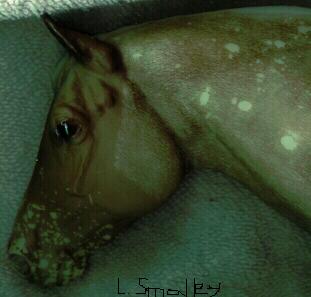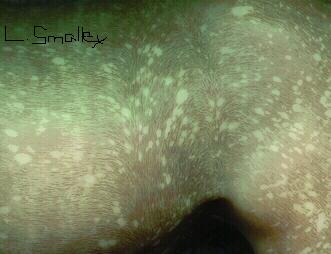Etching
Etching is when you take an original finish or customized model horse and scratch tiny lines of paint off with a sharp instrument. It makes the horse look as if it has hair.To etch, you need a model horse and a sharp instrument, such as an x-acto knife. It is sometimes better to have a new blade, because the tip is very sharp and it makes thin lines. Only the tip of the blade is used in etching, so you can still use the "old" blades for normal things that the knives are used for, skiving leather, or making other model horse items. Dull-tipped blades can be used if you want your hair strokes to be wider.
Another good thing to have is a foamy pencil grip. It's a little tube thing (1-2" long) that is made to be a pencil grip. I know that Walmart carries them in one of the office supply isles. They come in packs of 5 with assorted colors in them.
More good things to have are pleanty of band-aids!!! I ended up etching myself accidently quite a few times in the beginning. I would slip and my other hand would be in the wrong spot...
You will get the hang of it after a while, and you won't cut yourself as much.
It's a good idea to have a model horse that has flaws that you can use as your experimental horse, or even a body. Chances are that the first horse won't be open show quality. My first horse has patches of different types of strokes on it. The first horse will help you learn what technique you like the most. My second horse came out MUCH better, because I had established my stroking style.
Here is a scan of JAH's hair pattern chart so you can see the hair growth patterns: Click here to see it.
To etch, you probably need to have a lot of patience. It is very time-consuming to do full-body etching. My second horse, a Breyer Clayton took 40 hours to etch, because I was new at etching and he is highly detailed. My Big Ben is at least the 10th horse I have done, and the amount of time for him was about half of Clayton's time.
It's nice to keep track of what time you started and stopped etching in each session. That way, you will know how long each horse took you to etch!
Another tip is to not etch for a few hours in a row. I used to etch for a few hours in a row at each sitting, and I am now sorry for doing that. My hand will cramp up sometimes from etching, and my hand feels kind of tight all the time from it. My reccommendation is to etch for 2 hours or less at each sitting. I also bought 2 stretchy wrist braces to help with the cramping. Wearing gloves while etching also helps for some reason. I heard that wrapping your hands with vetwrap also helps with this sort of thing. (That's the next thing I will try!)
Here are a few scans of my Clayton:
(if the scans look dark on your computer, try lightening the picture
[there may be buttons on the bottom of your monitor to do this with].)
This is his unfinished face, so you can see the difference between etched and unetched:

This is his hip area:

Click on the 2 links below to see other examples of my etching.
Stock/Light/Sport Horses
Drafters
Click here to see the JAH hair growth pattern chart.
E-mail me!
Go back to my home page.
Background drawn and copyrighted by Lisa Smalley.
All picture copyrights are held by Lisa Smalley.
Last update: 8/21/00